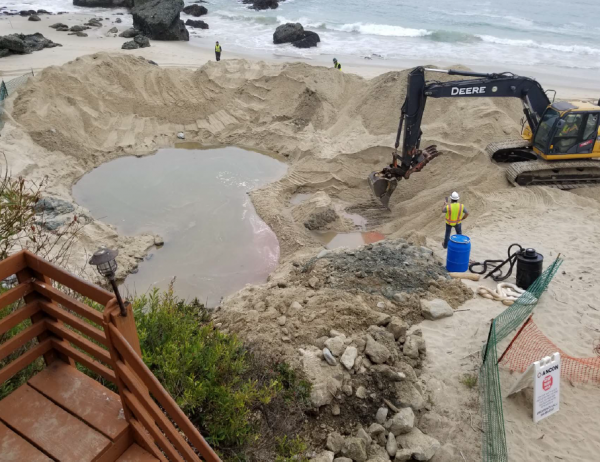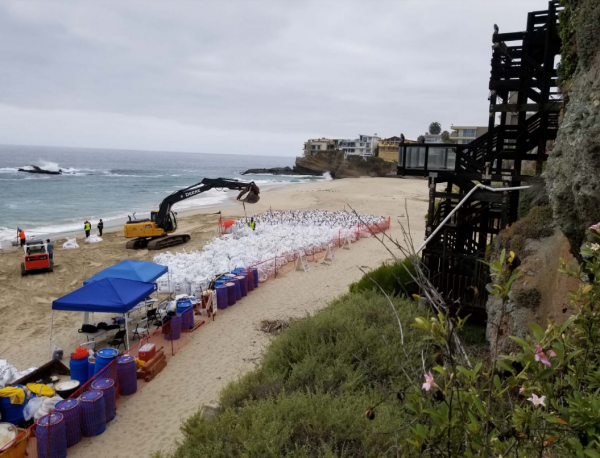
State water regulators don’t know how long it will take to complete the cleanup of a 2,100-gallon diesel spill at Mission Hospital that polluted Totuava Beach nearly two months ago.
The hospital and its consultants are getting closer to meeting environmental requirements but have not yet satisfied regulatory agencies, said Craig Carlisle, a senior geologist managing state oversight of the cleanup.
“The hospital has been highly motivated to do the right thing,” Carlisle said in a phone interview. “I don’t think this could be proceeding any quicker.”
As part of its normal operations, Mission Hospital regularly checks that its emergency electricity generator correctly functions, Laguna Beach Fire Chief Mike Garcia said. During these tests, the generator’s fuel tank is depleted and needs to be refilled by a second storage tank on site.
That system failed at some point in the early morning of May 7, spilling about 2,300 gallons, Garcia said. The diesel flowed into a storm drain before pooling on the sand beneath an outflow at Totuava Beach.
The U.S. Coast Guard was named as the incident’s lead agency shortly after the spill.
“We are conducting a full investigation into the root cause of the failure and will not re-instate the generator until we are confident we have exhausted all opportunities to ensure this will not happen again,” Mission Hospital spokesperson Carrie Miller wrote in an email. “We have a back-up in place in the event of a power failure.”
In early May, Mission Hospital tasked Carson-based Ancon with the cleanup, including excavating polluted sand and siphoning diesel and contaminated saltwater off the beach. Their initial response recovered more than 600 gallons of red dye diesel from Totuava Beach.
Since then residents have asked what happened to the remaining 1,500 gallons.
As the contractor dug five feet below the top of the sand, they found diesel on the surface of underground seawater. Crews recovered about 210 gallons of diesel on May 26 and another 100 gallons of diesel on May 28, according to emails sent to public officials from Mission Hospital’s environmental consultant.
When additional diesel wasn’t discovered on June 4, the contractor started focusing on removing the contaminated sand from the beach by using an excavator to load containers called Super Sacks.

A landing craft crew removed all remaining plastic sacks filled with diesel-impacted sand from the beach on June 22, according to public documents. The sacks were then placed on a barge that shipped them to the Port of Los Angeles for disposal.
California Coastal Commission staffers provided Ancon with guidance this week about the type of sand that should be used to backfill the excavated site.
Mission Hospital took about two weeks to submit a required work plan detailing how they plan to clean up Totuava Beach, a delay that Carlisle criticized in an internal email obtained by the Independent last month.
In the days after the spill, Carlisle criticized Mission Hospital’s contractor in an email to colleagues at the State Water Resources Control Board, according to state documents.
“The contractor seems to be new to environmental work and doesn’t see the need for an environmental work plan,” Carlisle wrote.
Ancon rejected the criticism, saying the company been in business for 52 years serving the industrial and environmental community.
“We have completed hundreds of environmental responses in conjunction with the U.S. Coast Guard, Fish and Wildlife, EPA, [California Department of Toxic Substances Control] and many other governing regulatory agencies,” company spokesperson Jacob Hardin wrote in an email. “Our compliance to process and administrative controls (Work Plan) have been reviewed and accepted by all of the governing agencies as it relates to this response.”
Carlisle walked back that criticism in a phone interview with the Independent late last month. He later explained that he wrote the statement in “the heat of the moment.”
“I’ve actually been pleased with how they’ve responded,” Carlisle said. “I give compliments to the hospital for acting so quickly.”
Carlisle has seen entities responsible for spills take up to 30 days to submit a work plan to environmental regulators. Mission Hospital’s consultants submitted their plan in half that time.
Government agencies’ response to the spill has been received “very poorly’ by residents of South Laguna—partly because of a lack of public communications, Greg O’Loughlin, president of the South Laguna Civic Association.
O’Loughlin was dismayed to learn about state officials’ initial criticism of the hospital’s contractor.
“Should I be surprised, no, but I am saddened that this is what it has come to,” O’Laughlin said.
He added his concern that the diesel spill’s cleanup may not receive the usual attention during the pandemic.
“You can’t use this as an excuse to act like this didn’t happen,” he said. “The common citizen is left to make up their own decisions.”




